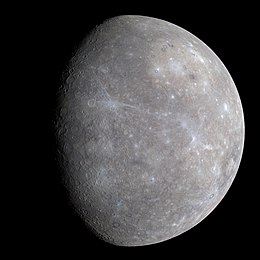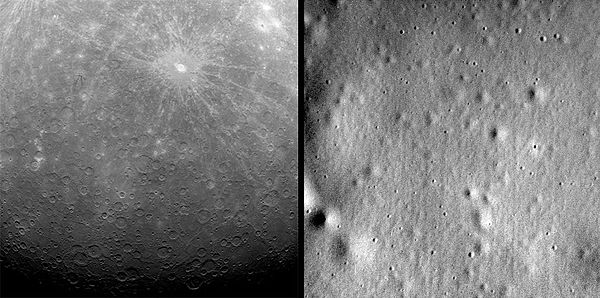ဗုဒ္ဓဟူးဂြိုဟ်
 မက်ဆင်ဂျာ အာကာသယာဉ်မှ မာကျူရီဂြိုဟ် (၂၀၀၈) ခုနှစ် | |||||||||||||
| အသံထွက် | /ˈmɜːrkjəri/ ( | ||||||||||||
|---|---|---|---|---|---|---|---|---|---|---|---|---|---|
| ပါဝင်အရာဝတ္ထုများ | Mercurian,[၁] Hermian | ||||||||||||
| ပတ်လမ်း ဂုဏ်အင်များ[၄] | |||||||||||||
| Epoch J2000 | |||||||||||||
| အဝေးဆုံးပတ်လမ်း |
| ||||||||||||
| အနီးဆုံးပတ်လမ်း |
| ||||||||||||
ဆီမီး မေဂျာ ဝင်ရိုး |
| ||||||||||||
| ပတ်လမ်း ဗဟိုကျမှု | 0.205 630[၂] | ||||||||||||
ပတ်လမ်း ကာလ | |||||||||||||
ပတ်လမ်း ကာလ | 115.88 d[၂] | ||||||||||||
ပျမ်းမျှ ပတ်နှုန်း | 47.362 km/s[၂] | ||||||||||||
ပျမ်းမျှ မူမမှန်မှု | 174.796° | ||||||||||||
| ပတ်လမ်း တိမ်းစောင်းမှု |
| ||||||||||||
Longitude of ascending node | 48.331° | ||||||||||||
Argument of perihelion | 29.124° | ||||||||||||
| ဂြိုဟ်ရံလများ | မရှိ | ||||||||||||
| ရုပ်ပိုင်းဆိုင်ရာ ဂုဏ်အင်များ | |||||||||||||
ပျမ်းမျှ အချင်းဝက် | |||||||||||||
| ပြားချပ်မှု | 0[၆] | ||||||||||||
မျက်နှာပြင် ဧရိယာ |
| ||||||||||||
| ထုထည် |
| ||||||||||||
| ဒြပ်ထု |
| ||||||||||||
ပျမ်းမျှ သိပ်သည်းဆ | 5.427 g/cm3[၅] | ||||||||||||
မျက်နှာပြင် ဒြပ်ဆွဲအား | |||||||||||||
အင်နားရှားကိန်း | 0.346±0.014[၈] | ||||||||||||
လွတ်မြောက်အလျင် | 4.25 km/s[၅] | ||||||||||||
ဘေးဘက် လှည့်ပတ်ကာလ |
| ||||||||||||
အီကွေတာ လည်ပတ်မှု အလျင် | ၁၀.၈၉၂ km/h (၃.၀၂၆ m/s) | ||||||||||||
ဝင်ရိုးတိမ်းစောင်းမှု | 2.04′ ± 0.08′ (to orbit)[၈] (0.034°)[၂] | ||||||||||||
မြောက်ဝင်ရိုးစွန်း ညာဘက် နိမ့်ဆင်းမှု |
| ||||||||||||
မြောက်ဝင်ရိုးစွန်း တိမ်းစောင်းမှု | 61.45°[၂] | ||||||||||||
| Albedo | |||||||||||||
| |||||||||||||
မြင်သာသော ပမာဏ | −2.6[၁၁] to 5.7[၂][၁၂] | ||||||||||||
ထောင့်ဖြတ်အချင်း | 4.5–13″[၂] | ||||||||||||
| လေထု[၁၃] | |||||||||||||
မျက်နှာပြင် လေထုဖိအား | trace (<~0.005 picobar) | ||||||||||||
| လေထု၌ ဓာတုပါဝင်နှုန်း |
| ||||||||||||
ဗုဒ္ဓဟူးဂြိုဟ် (အင်္ဂလိပ်: Mercury) သည် နေအဖွဲ့အစည်းအတွင်း၌ နေနှင့် အနီးဆုံးဂြိုဟ်ဖြစ်သည်။ ဗုဒ္ဓဟူးဂြိုဟ်သည် အလွန်သေးငယ်သော ဂြိုဟ်ဖြစ်ပြီး လကမ္ဘာကဲ့သို့ပင် မျက်နှာပြင်ပေါ်တွင် ချိုင့်ခွက်ကြီးများ ရှိသည်။ နေ့အခါတွင် အလွန်ပူပြီး ညအခါတွင် အလွန်အေးသည်။ အပြောင်းအလဲမှာ နေ့ဘက် ၄၂၇ ဒီဂရီ ဆဲဆီးယပ်စ်မှ ညဘက် အနုတ် ၁၇၃ ဆဲဆီးယပ်စ် ဖြစ်သည်။ ဝင်ရိုးစွန်းများမှာ အနုတ် ၉၃ ဒီဂရီ ဆဲဆီးယပ်စ်အောက်သို့ စဉ်ဆက်မပြတ် ရှိသည်။ မာကျူရီ၏ မြေမျက်နှာမှာ လကမ္ဘာကဲ့သို့ပင် ပေါ်လွင်သည်။ အလွန်ပြင်းထန်သော နေရောင်ခြည်တည်ရှိသော်လည်း မာကျူရီဂြိုဟ်ပေါ်တွင် နေရောင်ခြည်နှင့် မထိတွေ့သောနေရာ၌ ရေခဲတည်ရှိနိုင်သည်ဟု ရေစီးဆင်းသည့်ပုံစံများက ဖော်ပြနေသည်။ ၂ဝ၁၂ ခုနှစ်တွင် နာဆာ၏ MESSENGER အာကာသယာဉ်မှ ဝါရှင်တန်ဒီစီမြို့တော်နီးပါးခန့်ရှိသော ရေခဲလွှာကို မြောက်ဝင်ရိုးစွန်းတွင် ခြေရာခံမိသည်ဟု အတည်ပြုခဲ့သည်။
ပလူတိုကို ဂြိုဟ်များစာရင်းမှ ပယ်ဖျက်ခဲ့သော အချိန်မှစ၍ ဗုဒ္ဓဟူးဂြိုဟ်သည် နေအဖွဲ့အစည်းအတွင်း၌ အသေးဆုံးဂြိုဟ်ဖြစ်လာသည်။ နေနှင့် အနီးဆုံးဂြိုဟ်ဖြစ်သဖြင့် နေကို အမြန်ဆုံး လှည့်ပတ်နေသော ဂြိုဟ်ဖြစ်သည်။ နေကို တစ်ပတ်ပတ်ရန် ကမ္ဘာမြေရက် (၈၇.၉၇) ရက်မျှသာကြာသည်။ မာကျူရီဂြိုဟ်သည် နေအဖွဲ့အစည်းအတွင်း၌ သိပ်သည်းမှုအများဆုံးဂြိုဟ်ဖြစ်ပြီး ကမ္ဘာမှာ သိပ်သည်းမှု ဒုတိယအများဆုံးဖြစ်သည်။ ဗုဒ္ဓဟူးဂြိုဟ်သည် သံသတ္တုများဖြင့်ဖွဲ့စည်းထားသဖြင့် အလွန်သိပ်သည်းမှုများသည်။ သို့သော် အလွန်အားနည်းသော သံလိုက်စက်ကွင်းရှိသည်။ ကမ္ဘာဂြိုဟ် သံလိုက်စက်ကွင်း၏ ၁.၁ ရာခိုင်နှုန်းသာ တည်ရှိသည်။ မက်ဆင်ဂျာ အာကာသယာဉ်မှ ညွန်ပြသည်မှာ သံလိုက်စက်ကွင်းသည် တည်ငြိမ်သည်ဟုဆိုသည်။
ဗုဒ္ဓဟူးဂြိုဟ်သို့ မရိန်နာ ၁၀ (Mariner 10) နှင့် မက်ဆင်ဂျာ (MESSENGER) ဆိုသော အာကာသယာဉ် ၂ စင်း ရောက်ရှိခဲ့သည်။ မက်ဆင်ဂျာ အာကာသယာဉ်သည် ဂြိုဟ်အနီးမှ ဖြတ်၍ တစ်ကြိမ် ပျံသန်းခဲ့ပြီးဖြစ်သည်။ ၂၀၁၁ ခုနှစ် မတ်လမှ စတင်၍ ဂြိုဟ်ကို ၁ နှစ်ကြာမျှ လှည့်ပတ်ခဲ့သည်။ မက်ဆင်ဂျာ အာကာသယာဉ်သည် မာကျူရီဂြိုဟ်အား အကြိမ်ပေါင်း ၄၀၀၀ လှည့်ပတ်ခဲ့ပြီး ၂၀၁၅ ခုနှစ် ဧပရယ်လ ၃၀ တွင် လောင်စာကုန်ခမ်းကာ ဂြိုဟ်ပေါ်သို့ ထိုးကျခဲ့သည်။[၁၄][၁၅][၁၆]

ဗုဒ္ဓဟူးဂြိုဟ်၏ အင်္ဂလိပ်အမည် မာကျူရီကို ရောမဘုရား၏ အတောင်ပံပါသော တမန်တော် ၏ အမည်ကို အစွဲပြု၍ မှည့်ခေါ်ခြင်းဖြစ်သည်။ အဘယ်ကြောင့်ဆိုသော် နေကို အလွန်လျင်မြန်စွာ လှည့်ပတ်သောကြောင့်ဖြစ်သည်။ မာကျူရီဂြိုဟ်အား မြေပြင်မှလေ့လာမယ်ဆိုပါက အလွန်ခက်ခဲမည်ဖြစ်သည်။ အဘယ်ကြောင့်ဆိုသော် မာကျူရီသည် နေနှင့် အလွန်နီးကပ်သောကြောင့် ဖြစ်သည်။ တရုတ်၊ ကိုရီးယားနှင့် ဂျပန်ယဉ်ကျေးမှု တို့၌ မာကျူရီဂြိုဟ်ကို ရေနှင့်ဆိုင်သောကြယ်ဟု ဖော်ပြကြသည်။
မာကျူရီဂြိုဟ်တွင် ဂြိုဟ်ရံလ မရှိပေ။

ကိုးကား
[ပြင်ဆင်ရန်]- ↑ mercurial။ Merriam-Webster Online။ 2008-06-12 တွင် ပြန်စစ်ပြီး။
- ↑ ၂.၀ ၂.၁ ၂.၂ ၂.၃ ၂.၄ ၂.၅ ၂.၆ ၂.၇ Mercury Fact Sheet။ NASA Goddard Space Flight Center (November 30, 2007)။ 2008-05-28 တွင် ပြန်စစ်ပြီး။
- ↑ The MeanPlane (Invariable plane) of the Solar System passing through the barycenter (2009-04-03)။ 14 May 2009 တွင် မူရင်းအား မော်ကွန်းတင်ပြီး။ 2009-04-03 တွင် ပြန်စစ်ပြီး။ (produced with Solex 10 Archived 18 September 2015 at the Wayback Machine. written by Aldo Vitagliano; see also Invariable plane)
- ↑ Yeomans၊ Donald K. (April 7, 2008)။ HORIZONS Web-Interface for Mercury Major Body။ JPL Horizons On-Line Ephemeris System။ 2008-04-07 တွင် ပြန်စစ်ပြီး။ – Select "Ephemeris Type: Orbital Elements", "Time Span: 2000-01-01 12:00 to 2000-01-02". ("Target Body: Mercury" and "Center: Sun" should be defaulted to.) Results are instantaneous osculating orbit|osculating values at the precise J2000 epoch.
- ↑ ၅.၀ ၅.၁ ၅.၂ ၅.၃ ၅.၄ ၅.၅ ၅.၆ Munsell၊ Kirk (May 28, 2009)။ Mercury: Facts & Figures။ Solar System Exploration။ NASA။ 19 November 2002 တွင် မူရင်းအား မော်ကွန်းတင်ပြီး။ 2008-04-07 တွင် ပြန်စစ်ပြီး။
- ↑ ၆.၀ ၆.၁ "Report of the IAU/IAG Working Group on cartographic coordinates and rotational elements: 2006" (2007). Celestial Mechanics and Dynamical Astronomy 98 (3): 155–180. doi:. Bibcode: 2007CeMDA..98..155S.
- ↑ "The gravity field, orientation, and ephemeris of Mercury from MESSENGER observations after three years in orbit" (2014). Journal of Geophysical Research: Planets 119 (12): 2417–2436. doi:. ISSN 21699097.
- ↑ ၈.၀ ၈.၁ "Mercury's moment of inertia from spin and gravity data" (2012). Journal of Geophysical Research: Planets 117 (E12). doi:. ISSN 01480227. Bibcode: 2012JGRE..117.0L09M.
- ↑ ၉.၀ ၉.၁ Mallama, A. (2002). "Photometry of Mercury from SOHO/LASCO and Earth". Icarus 155 (2): 253–264. doi:. Bibcode: 2002Icar..155..253M.
- ↑ ၁၀.၀ ၁၀.၁ "Near-Surface Temperatures on Mercury and the Moon and the Stability of Polar Ice Deposits" (19 February 1999). Icarus 141 (2): 179–193. doi:. Bibcode: 1999Icar..141..179V. Figure 3 with the "TWO model"; Figure 5 for pole. Archived 13 November 2012 at the Wayback Machine.
- ↑ Mallama, A. (2011). "Planetary magnitudes". Sky and Telescope 121 (1): 51–56.
- ↑ Espenak၊ Fred (July 25, 1996)။ Twelve Year Planetary Ephemeris: 1995–2006။ NASA Reference Publication 1349။ NASA။ 2008-05-23 တွင် ပြန်စစ်ပြီး။
- ↑ Mercury Fact Sheet။ NASA (22 December 2015)။ 6 November 2015 တွင် မူရင်းအား မော်ကွန်းတင်ပြီး။ 27 January 2016 တွင် ပြန်စစ်ပြီး။
- ↑ NASA Completes MESSENGER Mission with Expected Impact on Mercury's Surface။ May 3, 2015 တွင် မူရင်းအား မော်ကွန်းတင်ပြီး။ April 30, 2015 တွင် ပြန်စစ်ပြီး။
- ↑ From Mercury orbit, MESSENGER watches a lunar eclipse။ Planetary Society (October 10, 2014)။ January 23, 2015 တွင် ပြန်စစ်ပြီး။
- ↑ Innovative use of pressurant extends MESSENGER's Mercury mission။ Astronomy.com (December 29, 2014)။ January 22, 2015 တွင် ပြန်စစ်ပြီး။

